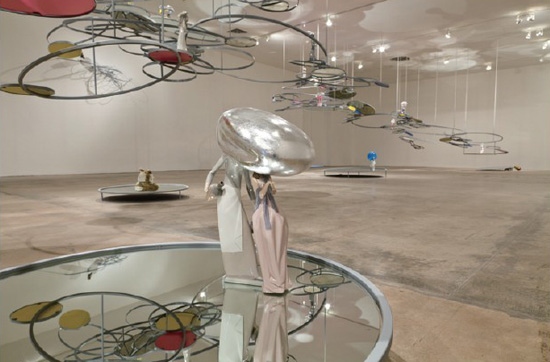|
Introduction of the artist:

Ruth CLAXTON (UK)
Born in 1971, Ipswich, UK. Lives and works in Birmingham, UK. Selected solo
exhibitions: 2011 Synthetic Worlds, SITE, Santa Fe, USA / Postcards, Nottingham
Contemporary, UK / 2009 Lands End, Faye Fleming and Partner, Geneva / 2008 Lands
End, Ikon Gallery, Birmingham, UK / Selected group exhibitions: 2010 Remake,
Remodel, National Glass Centre, Sunderland, UK / 2010 Undone, Henry Moore
Institute, Leeds, UK / 2009 Known Unknowns, Gallery Loop, Seoul.
Introduction of works:

Specular Spectacular, dimensions variable, 2011, courtesy Site, Santa
Fe

Synthetic Worlds, detail, installation, dimensions variable, 2012
Ruth Claxton’s work engages with the material world whilst raising questions
about our increasingly mediated experience of it through information technology.
Early works were made utilising modified furniture populated with numerous
ceramic figurines she had collected from second-hand markets or junk shops.
These sported colourful protuberances or organic growths rendering them blind,
their heads suffocated by a seemingly sci-fi morphing of artificiality -
sequins, ribbons, stationery accoutrements. That their sight was denied, their
experience of things muted, sat at odds with the very physicality of that which
rendered them blind. As a metaphor for our technological engagement, it raised
questions of what the dangers and implications might be of such insularity,
welcomed almost without question, yet simultaneously, paradoxically retaining
our individuality through blinkered additions. Figures stood in wonder in the
midst of these new lands, in sublime awe at the brave new world rolling out at
their feet in waves of ever increasing technological advance.
A more recent development has been the removal of the furniture – with
patinas of use and stylistic histories - to be replaced with steel fabrications
giving structure to this other worldly topography. Painted in tones of pale
grey, the organising principle of such stands recall the more utopian aspects of
modernist modular display and design, while relieving the work of its domestic
overtones. The resultant installations can be read as new geographies with the
further introduction of coloured and mirrored surfaces multiplying formal and
conceptual complexity. As views proliferate through reflection, the mix and
visual confusion simultaneously collapses and extends space. Fractured and
reversed, versions of reality are interwoven with that which is virtual;
navigation becomes convoluted and we enter a world in flux, shifting from the
tangible to the immaterial.
| 
